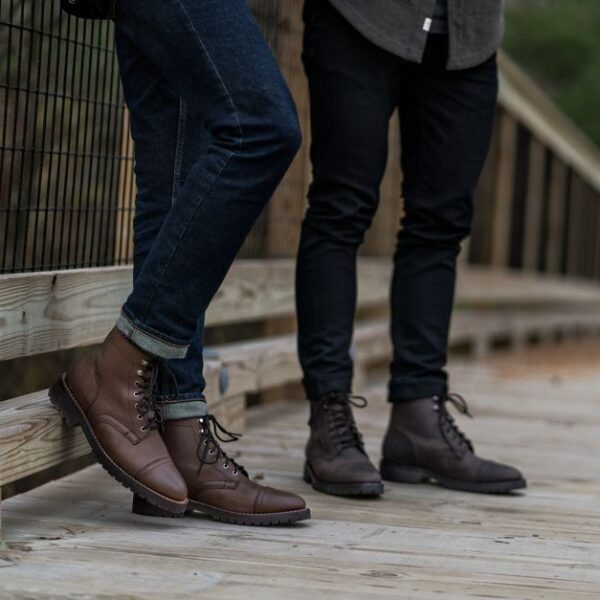These Are The Types of Suit Fabrics You Need To Know To Elevate Your Style Game
Today we answer the big question, what fabric are suits made of? a suit refers to a multiple-piece set of clothing that is usually the dressiest or nicest thing in a man’s closet – unless he owns a tuxedo. While there are different types of suits, the most well known is a business suit and typically consists of 2 items – a jacket and pair of pants. However, dressier suits consist of a third item – a vest, or waistcoat.
The name itself, suit, has its origins in a set of clothing that consists of even more items. A suite was a set of clothing that could consist of 6 different garments and was popular for English royalty in the 14th Century. A robe, another term for which the meaning has changed over the years, contained numerous suites.
Over the next half a millennium, a suite, or suit, gradually lost pieces until it became only 2 or 3 items – luckily for men everywhere. There are a couple of things that have remained the same over the years. The first is that a proper suit should be tailored. Second, that there are several different suit fabric types – but always the same type across a single suit.
So, What Fabric Are Suits Made Of?
Well, quite a few actually. Let’s go through the list and see the differences and benefits of each fabric type in suit construction
Types & Patterns in Wool:
The classic style of suit you see in offices in mild to cold climates is made of wool.
Houndstooth
A twill weave that is made with four dark threads and four light threads. They are woven in a way that creates a checkered pattern or, according to some, a pattern that resembles the teeth of a dog. Hence, the name.
Barleycorn
Also a twill weave made by contrasting the vertical and horizontal threads. This results in tiny triangles that resemble kernels of corn, which is where the name comes from. Barleycorn suits are appropriate for business or daily wear but is also a popular pattern for sports jackets, usually when the material is lambswool or cashmere.
Herringbone
Vaguely resembling the bones of a fish, herringbone is a twill weave made by threads that run to the left and the right alternatively which results in a v-shape. Herringbone is also popular for suits and sports jackets.
Pinstripe
Perhaps the classical suit pattern, pinstripe is a plain weave achieved with contrasting yarns – usually white and black but can include grey or dark blue.
Pick-and-Pick (Sharkskin)
Another twill weave worsted suiting that is woven in a way that creates a salt and pepper-like effect. Typically a dressier pattern that is usually popular with businessmen.
Glencheck
A twill design made with two dark and two light stripes alternating with four dark and four light stripes creating a crossing pattern of irregular checks. The colors are usually black or grey and white.
Types & Patterns of Tweed:
Tweed suits are a class of coarse and colorful suits. Tweed, originally called tweel then later tweed thanks to a clerical error, was a Scottish version of twill. It slowly caught on in England and therefore, the rest of the world.
There is also an Irish tweed which is more colorful with larger patterns versus the Scottish version.

Harris
A rugged and bulky tweed. A Harris tweed suit would typically be too warm for summer wear. The Harris Tweed Association certifies Harris tweed that actually comes from Outer Hebrides of Scotland.
Shetland Cheviot
Shetland Cheviot is a fishbone-patterned tweed, distinguished by its straight lines rather than the V-shaped pattern found in herringbone. Known for its grainy texture and substantial weight, this classical weave is typically crafted from wool. It is particularly valued for its durability and rugged charm, making it ideal for cooler climates or outdoor wear. Shetland Cheviot tweed is often used in sport coats and jackets that pair well with both casual and semi-formal attire.
Plaid
Plaid tweed is instantly recognizable for its bold, box-like pattern created by cross-hatched yarns. While its striking design is eye-catching, it is generally unsuitable for formal or business settings unless made with subtle color contrasts, such as a restrained palette of grey, black, and white. Plaid suits are excellent for casual or smart-casual occasions, where their personality and visual interest can be fully appreciated.
Gabardine
Gabardine is a tightly woven fabric, almost like worsted wool, which makes it exceptionally durable and nearly water-resistant. This material consists of more vertical threads than horizontal ones, giving it a distinct diagonal ribbed texture. Gabardine’s structure allows it to drape smoothly, making it ideal for tailored suits, overcoats, and trousers. Its versatility ensures it can be worn year-round, though its slightly heavier weight may feel more comfortable in cooler weather.
Types & Patterns in Cotton:
Cotton, derived from the seed pods of the cotton plant, is one of the most practical and widely used materials in suiting. After the raw cotton is separated from the bolls, it is spun into yarn and woven into fabric. Cotton suits are valued for their durability and ability to withstand frequent washing without damage.
They are also incredibly versatile and easily dyed, making them available in a wide range of colors and patterns. However, cotton does not retain heat well, so these suits are most commonly worn in warmer months. Popular cotton suit fabrics include:

- Seersucker: Woven with alternating tension to create a puckered texture, seersucker suits are lightweight and breathable. Originally made from silk in India, the name “seersucker” comes from the Hindi phrase meaning “milk and sugar,” referencing its smooth and rough textures.
- Corduroy: Featuring thick, ribbed ridges, corduroy suits offer a unique texture. While they carry an academic or vintage vibe, when styled well, corduroy suits can make a bold fashion statement.
Other Common Fabrics:

Velvet
Velvet is an opulent fabric often reserved for eveningwear or special occasions. While full velvet suits are rare, velvet jackets, often referred to as smoking jackets, add a sophisticated touch to formal events. The lush texture and sheen of velvet make it a statement piece in any wardrobe.
Denim
Denim, with its origins in Nîmes, France (“serge de Nîmes”), is synonymous with American fashion. Though unconventional for suiting, denim suits have gained popularity as a fashion-forward statement. They are more appropriate for creative or casual settings than for traditional business attire.
Linen
Linen, extracted from the stalk of the flax plant, is prized for its breathability and lightweight feel, making it an excellent choice for summer suits. The labor-intensive process of producing linen results in a material with a natural texture and slight sheen. While linen suits are known for their tendency to crease, many consider this part of their charm.
- Irish Linen: Known for its compact weave, Irish linen creases less and is typically crafted in solid colors, making it slightly more formal than other linen varieties.
- Italian Linen: Softer and with a looser weave, Italian linen has a luxurious feel but creases more easily, limiting its use to casual or semi-formal occasions.
Silk
Silk, first discovered in ancient China, is derived from the cocoons of the Bombyx mori caterpillar. The process of producing silk is intricate, requiring the harvesting of multiple cocoons for a single thread of fabric. Known for its luxurious sheen and smooth texture, silk is often associated with opulence.
Common silk suit fabrics include:
- Satin: Recognized by its glossy finish on one side and matte surface on the other, satin is used sparingly in men’s suits, often for waistcoats or tuxedo lapels.
- Shantung: A textured, durable silk with a coarse feel, Shantung is more commonly used for formalwear accessories like waistcoats.
Precious Fibers
Luxury suits crafted from rare fibers exude sophistication and exclusivity. These materials are typically reserved for high fashion or bespoke tailoring.

- Cashmere: Made from the undercoat of the Asian mountain goat, cashmere is incredibly lightweight yet warm and durable. It’s suitable for both business and casual settings, offering an unparalleled level of comfort and elegance.
- Mohair: Derived from the Angora goat, mohair is known for its natural sheen and crisp texture. It’s a popular choice for formal and business suits, offering a polished and professional appearance.
- Baby Alpaca: Taken from the first shearing of a young alpaca, this fiber is exceptionally soft, silky, and lightweight. Baby alpaca suits are ideal for colder weather and convey understated luxury.
- Vicuna: One of the rarest and most expensive fibers in the world, vicuna comes from an elusive South American camelid. Its softness and warmth are unmatched, but the fleece is typically used for jackets rather than full suits due to its cost and exclusivity.
We can look at what fabric suits are made of with some examples
Mens Classic Fit Two Button 100% Wool 2 Piece Suit
Worsted Suitings
Worsted material is a high-quality wool that is especially light. Suits made of worsted material and designed to be worn during the hot summer months might weigh less than 8 ounces.
There are many worsted suit fabric types, each identified by the weave. The most well known of which are in the adjacent accordion.
Men’s 3 Piece Suit Wool Tweed Herringbone

Wool
Wool was an obvious choice of general clothing material ever since the ancient civilizations of Mesopotamia, when the wool was worn still attached to the skin of the sheep.
People started to wear wool primarily because of its ability to not only keep a person warm, but also because it could keep someone cool. Additionally, wool absorbed water and is a durable material.
There are two dominate weaving patterns of wool, or any material for that matter – plain weave, which is an over-and-under pattern, and twill weave, which is made by interlacing the vertical and horizontal yarns creating a slanted pattern.
Perhaps due to its practical uses, wool stood the test of time and likely first caught on in England, especially after the invention of spinning. Wool eventually became the classical suit fabric type – though there are variations in how it is processed.
We learnt a lot about the type of suit fabric and what fabric suits are made of
We hope our handy little guide helped you make an informed decision about what type of suit fabric you should be choosing for your next suit whether that be in the office or for a wedding. We also now know with certainty what fabric are suits made of. We here at Modern Follicle love fashion and love what we do. Don’t be a stranger and check out some of our other great work such as finding out what the best dive watches are and what Post Malone looks like in full cowboy mode. Leave a comment too if you enjoyed or found informative what you read!








